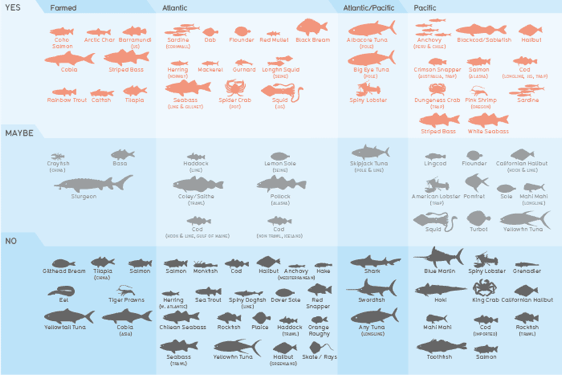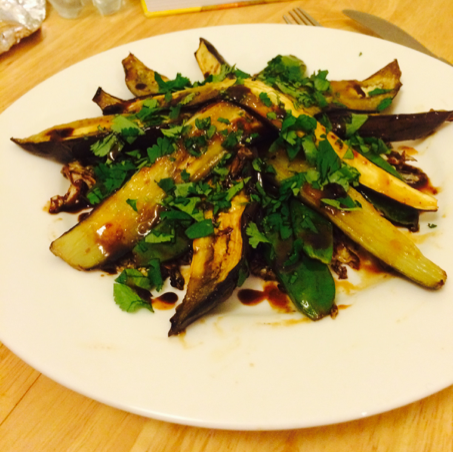For me, becoming a pescatarian was an easier transition into vegetarianism. Many claim they could give up meat more easily than fish. Others do not class fish as a type of meat. Fish are generally viewed as healthier and less harmful than meat — but to what extent is this true?
Last week’s article highlighted the effects of red/processed meat on health. Unsustainable, non-organic, intensive farming rears animals in poor conditions, often treating livestock with a range of antibiotics or hormones. An abundance of meat products in supermarkets are processed, hydrated or preserved, and it is no secret that eating such meats has negative health consequences.
Fish, on the other hand is seen in a different light. From an ethical stance, fish neurology is of a lower complexity than mammals and arguably, fish suffer less from pain. In terms of health benefits, fish are rich in omega-3 and have been shown to reduce risk of cardiovascular disease (1). (Although there are plenty of alternatives e.g. flax seeds, walnuts or soya beans.) However, current fishing practices and over-fishing poses an environmental, social and economic threat.
Since 1970, fish and marine vertebrate populations have halved. Scombridae, the most commonly consumed family of fish, including tunas, mackerels and bonitos, have fallen in population by 74% (2). Among pollution and climate change, unsustainable fishing practices hold huge responsibility in threatening ocean ecosystems. Commercial fishing methods such as bottom-trawling and long-line fishing catch a large number of ‘undesired’ fish, whilst dredging proves destructive to aquatic ecosystems.
Deforestation (particularly from cattle ranching) is known to have a huge impact on CO2 emissions; but despite the ocean being the world’s largest carbon sink, there is less fear surrounding consequences of depleting oceanic ecosystems. However, aquaculture (i.e. fish farming), sometimes using wild fish to feed desirable fish species, can spread disease from farmed fish populations into wild populations.

Figure 1: McCandless D. Which Fish are Okay to Eat? [internet]. 2011 [cited 27/02/16]. Available from: http://www.davidmccandless.com/projects/which-fish-are-okay-to-eat/
Over-fishing is too a humanitarian issue. With 12% of the global population relying on fisheries as a livelihood, there is a strong need for a sustainable commitment to fishing practices. Fortunately, there is an increase in large industries (such as John West) switching to Marine Stewardship Council (MSC) certified fishing. Yet, a large proportion fish in the UK is not MSC certified. The number of MSC certified products also varies between supermarkets.
Whether or not you wish to continue to eat fish, or reduce your consumption, there are always considerations to be made. A nifty infographic ‘Which Fish are Okay to Eat?’ by David McCandless (owner of information is beautiful) has summarised the sustainability of fish based on Marine Conservation Society (3), Greenpeace (4) and SeaFood Watch data. If you are still unsure, you can simply type the name into here for a recommendation based on environmental impact by SeaFood Watch. However, it is important to remember that these are only guidelines; large organisations such as MSC may have loopholes or inconsistencies. Through weighing up my love of seafood and the strain it is putting on oceans, I have decided to cut out fish from my diet – as sadly, there are not plenty of fish in the sea.
Author: Victoria Fernandes
References
- Kris-Etherton P. Fish Consumption, Fish Oil, Omega-3 Fatty Acids, and Cardiovascular Disease. Circulation. 2002;106(21):2747-2757.
- org.uk. Crisis in global oceans as populations of marine species halve in size since 1970 [Internet]. 2015 [cited 3 March 2016]. Available from: http://www.wwf.org.uk/about_wwf/press_centre/?unewsid=7673
- Marine Conservation Society UK. Sustainable Seafood at a Glance [Internet]. 2011 [cited 3 March 2016]. Available from: http://www.mcsuk.org/downloads/fisheries/fishweek/FishWeek_FishList_Jan2011.pdf
- org.uk. Sustainable seafood: what fish can I eat? | Greenpeace UK [Internet]. 2012 [cited 3 March 2016]. Available from: http://www.greenpeace.org.uk/oceans/what-you-can-do/better-buys-what-fish-can-I-eat




